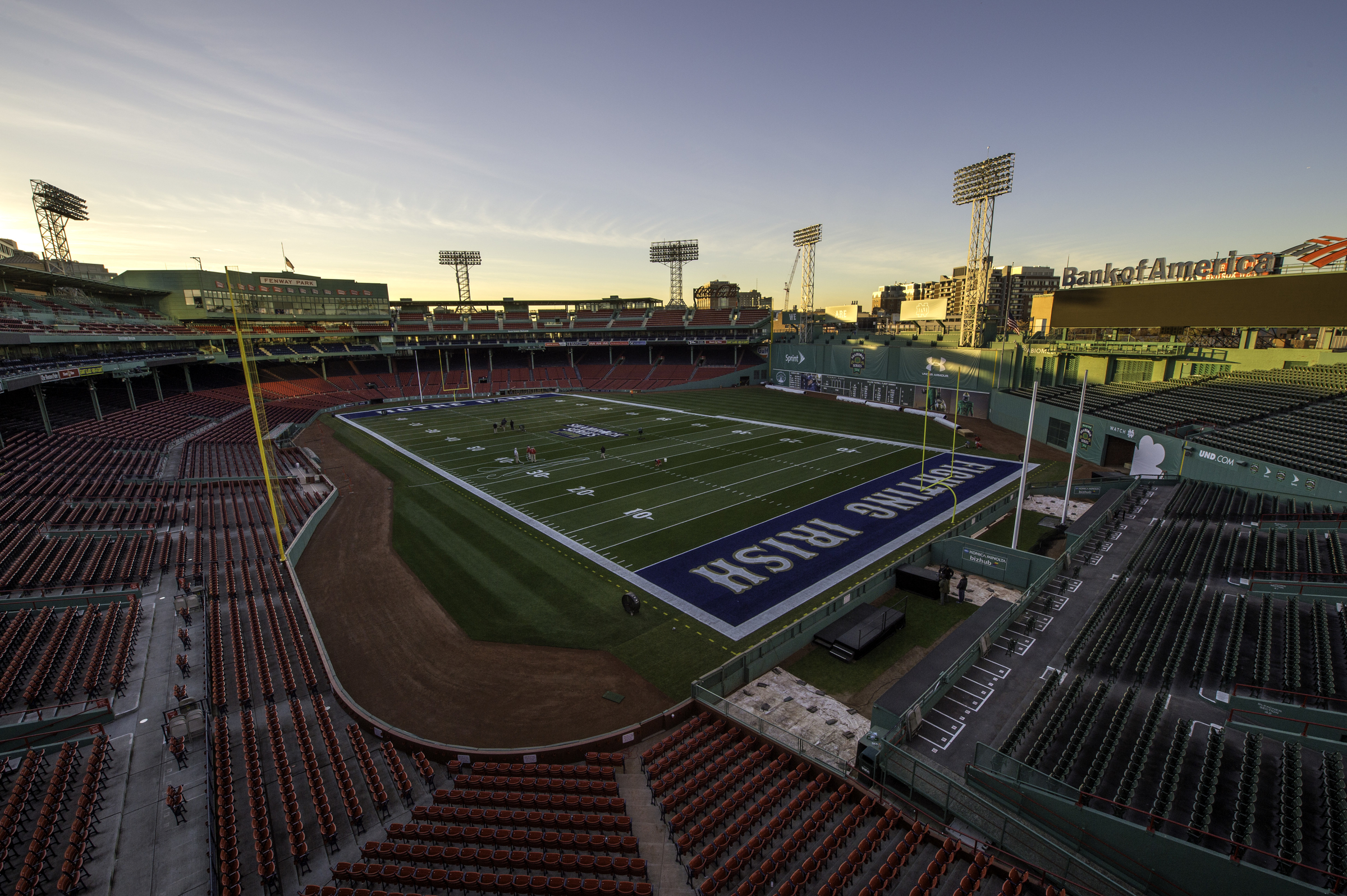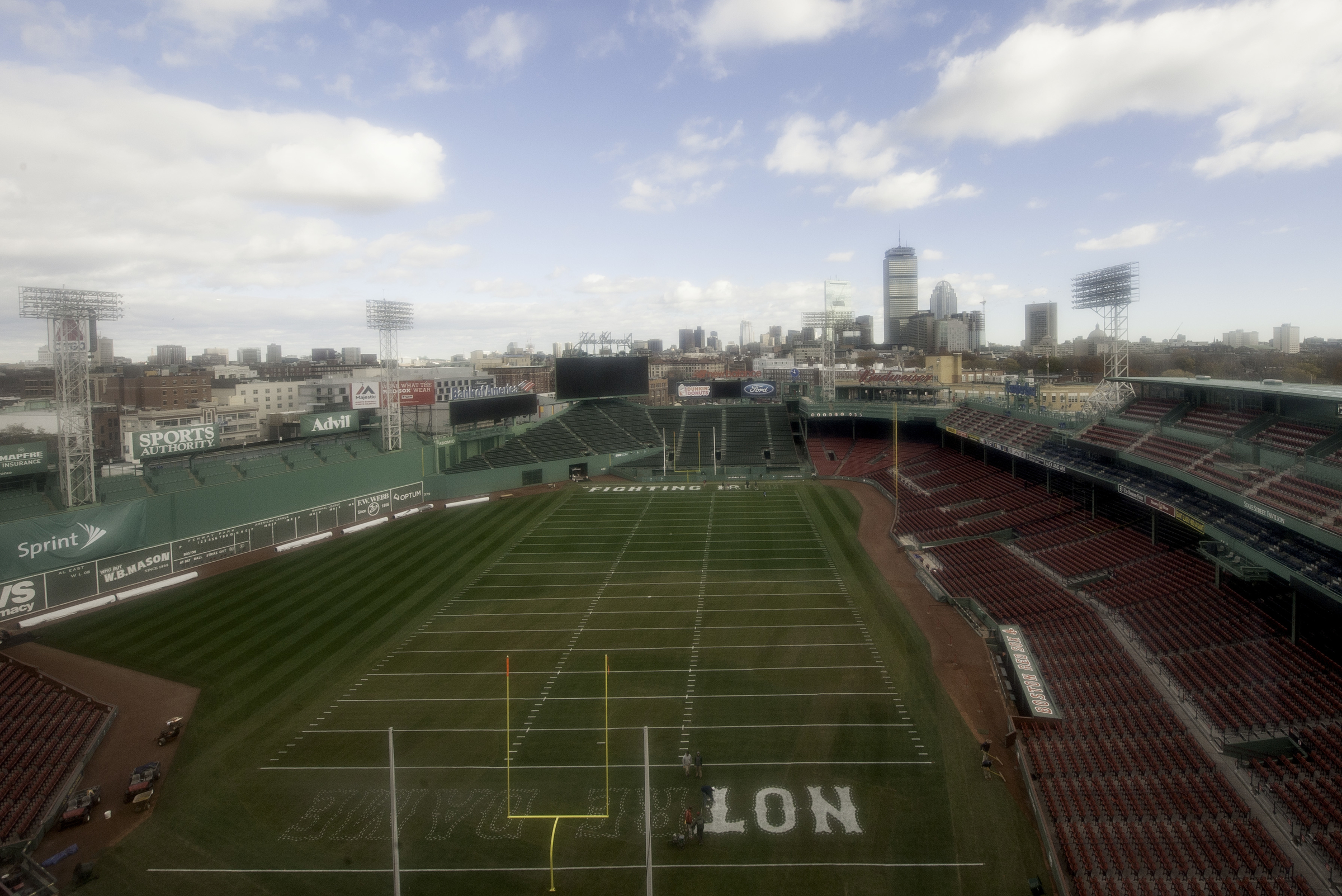This Is How Fenway Park Was Transformed into a Football Field

By Michael Ivins/Boston Red Sox
For the first time in 47 years, football will be played at Fenway Park on Saturday, when the Notre Dame Fighting Irish host their annual Shamrock Series against the Boston College Eagles. It’s the most expensive ticket in college football this season, as the median price for a seat is a cool $900.
There are a number of reasons for the exorbitant price, such as the fact that BC was only allotted 5,000 tickets for the game because it’s the away team, but perhaps the biggest reason is the novelty of seeing football played at Fenway. For this weekend, the 103-year-old baseball cathedral has replaced its infield and pitcher’s mound with goal posts and end zones.

Photo by Michael Ivins/Boston Red Sox
The process of converting Fenway into a full-fledged football stadium is taxing and strenuous. The grounds crew has been at work since the start of the month, readying America’s Most Beloved Ballpark to host arguably America’s most historic college football team. Fenway Park’s head groundskeeper, Dave Mellor, provided Boston with an inside look at the project.
Before the paint, the end zones, and football… there had to be field goal posts! 

 #ShamrockSeriespic.twitter.com/WGjxFWfMbR
#ShamrockSeriespic.twitter.com/WGjxFWfMbR
— Fenway Park (@fenwaypark) November 16, 2015
What steps are involved?
First, the field is surveyed to make sure everything lays out just right. Then we came in and clipped all of the infield edges of the clay, the baseline, home plate, the coaches boxes, fungo circles, [warning] track edges, and the backside of the infield. All of that sod was taken out so we could make a nice, smooth transition to those areas.
Then the pitcher’s mound was taken out—it’s five tons of clay just from the ground-level up—we had clay below ground also. All of that clay is taken out and shoveled with pick axes.
Then the end zones were put in, and we put a filter fabric down on top of all our clay so when we put sod on top of it, we don’t risk any kind of cross-contamination from the sod soil that’s under there that could affect baseball next year. We also use a product called Turface, which is a soil conditioner that we use on our infield and helps with moisture management. It helps the sod have some moisture, but it also prevents it from getting sloppy.

Photo by Michael Ivins/Boston Red Sox
How difficult was this to pull off?
This is my 30th year in the Major Leagues and when I worked for the Milwaukee Brewers, eight of those years the Green Bay Packers played half of their home games and preseason games in Milwaukee. The field fits much better here than it did there. The technology that we have nowadays in turf grass management allows us to have a better, safer playing field than the fields that were played here in the ’60s. Back in ’68, when football was played at Fenway, it was an old soil-based field, and soil-based fields have a big crown to them—kind of like a turtle’s back—because the water wouldn’t drain through the soil. It would have to run off.
After the ’04 World Series, we ripped the old field out of here and put a new field in that had sub-surface drainage and automatic irrigation. We got rid of the 18-inch crown that was here to make it much flatter and as a result, the field is much improved from when they played here in the ’60s.
Watch the #RedSox grounds crew take #FenwayPark to another level in preparation for #NDvsBC. 

 #ShamrockSeries pic.twitter.com/kSmI8VOAw3
#ShamrockSeries pic.twitter.com/kSmI8VOAw3
— Fenway Park (@fenwaypark) November 13, 2015
How does it compare to putting a hockey rink inside Fenway, which you do every winter for the Frozen Fenway series?
The main difference between this event and hockey is a full-field renovation. Football certainly has much more maintenance and attention to detail. There’s much more fine-tuning involved than hockey.
Hockey is put on dormant grass on the field that’s coming out. In the spring, we put a new field in. This has all of the sod that’s put over the top of the infield, the baseline, and home plate. The mound comes out and then the mound goes back in. After November 30, we’ll take all of this sod out and then start putting the mound back in.
So football is certainly a lot more attention to detail. My co-workers have been on their hands and knees with every sod seed that’s here.

Photo by Michael Ivins/Boston Red Sox
What’s the best seat in the house?
I’m not sure there’s a bad seat. You’ve got two incredible teams playing, so I think even standing room would be an experience. The aura of Fenway for any event is special.

